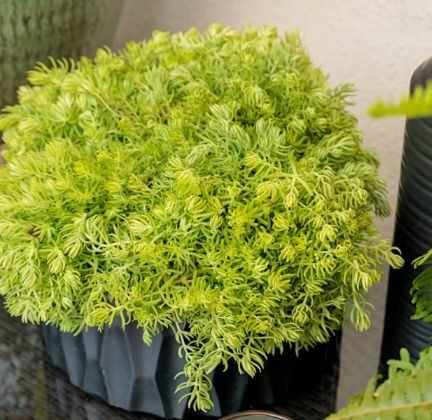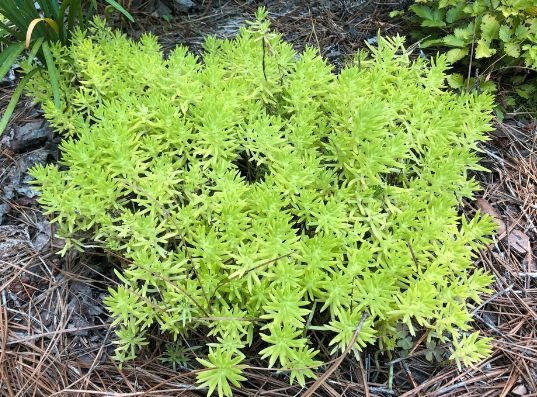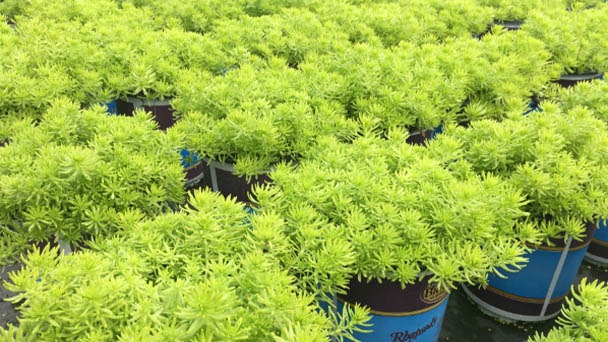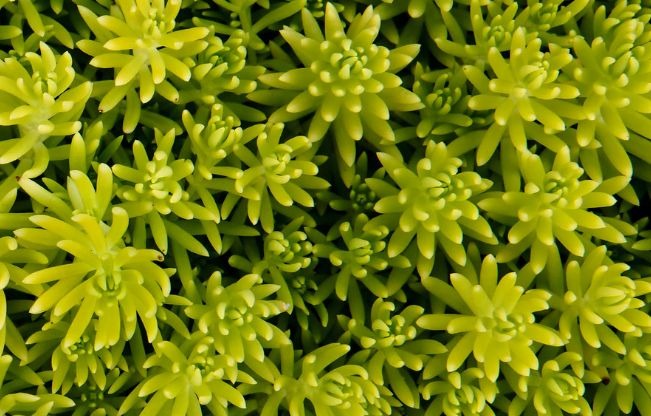Despite being a brighter color and a little taller, Lemon Coral Sedum differs from Sedum Angelina in appearance. It is a compact, golden-yellow, mound-forming dwarf Sedum with a tight, spreading, or trailing habit that makes it ideal for sunny borders, rock gardens, or spilling from containers.
This selection of bright lemon yellow is similar to Sedum Angelina in appearance, but it is more vivid and taller. It is a dense golden yellow mounding dwarf Sedum with a tight and spreading to trailing habit, making it ideal for sunny borders, rock gardens, or spilling from containers.
Common Names for Lemon Coral Sedum
Every region has a name for a particular plant that they refer to according to their convenience. Other names with which you can refer to this plant are
- Lemon Coral
- Lemon Coral Sedum
- Sedum mexicanum lemon coral
- Sedum Lemon Ball
- Petrosedum reflexum ‘Lemonball'
- Lemonball Sedum
- Sedum rupestre ‘Lemonball'
- Sedum mexicanum ‘Lemon Ball'
Features of the Lemon Coral Sedum
When choosing a plant to grow, a plant's characteristics are most important. When a plant's characteristics are found to be convenient for a person, they typically grow that plant. For those who grow plants indoors, for instance, you'll need some low-growing, less-poisonous plants. Plants grown in gardens, on the other hand, are not problematic if they reach a greater height. Some of the features that distinguish lemon coral plants from others are:
Height
These plants don't grow to greater heights because they are typically grown as groundcovers. Between 0.25 and 0.75 feet is the largest size this plant can reach. These plants can also spread throughout the ground because they are creeping plants. In the ground, they can therefore spread out up to one or two feet.
Flowers
Angiosperms are flowering plants, and this particular plant is one of them. It produces tiny, mostly star-shaped flowers. This plant's flowers are typically lime green, but they can also be gold or yellow. This plant's flowers can reach a height of one inch. This plant's flower inflorescence can be referred to as a cyme. Most of the summer is when this plant blooms.
Leaf
Simple, mostly fleshy and prickly leaves make up the lemon coral plant. Green or yellow are typically the colors of the leaves. The leaves have a linear shape and can get up to an inch long.
Tolerance
The ability of a plant to tolerate stress and endure difficult circumstances is referred to as tolerance in plants. These plants have an exceptionally high level of tolerance. Droughts, dry soil, and poor soil can all be tolerated by these plants.
Perennial
Lemon coral, which can live for many years, is what gives rise to the term "perennial" for sedum. This plant can endure droughts for a longer period of time because of its high resistance properties.
Non-toxic
These plants have zero toxic potential. These plants are suitable for nibbling by your pets, such as dogs, in the garden. Avoid using sprays on these plants if your dog likes to graze in the garden. If not, your dog or any other pet could suffer harm.
Ground Cover
Your garden can benefit from having a carpet made of these plants. Lemon coral's mounded to trailing growth habit makes it the ideal plant to add to any floral setting. For this plant to grow properly, a space of 16 to 24 inches is needed.
Lemon Coral Sedum Care
Light
Lemon Coral Sedum can tolerate both full sun and part shade, though too much shade can make the foliage lose its vibrant yellowish hue. It benefits from a location in full sun, which enhances its yellow foliage. It has a very high tolerance for smog and can even thrive in densely populated areas.
Temperature
USDA zones 7 to 11 are ideal for growing Sedum mexicanum 'Lemon Coral'. Once established, this plant, which is well-known for thriving in the heat, will become a go-to for the sunniest, driest areas of your garden or yard. Actually, compared to other Sedum species, this lemon-looking plant can withstand heat better.
Lemon Coral Sedum prefers sandy to gravelly soils of moderate to low fertility and needs good soil drainage, but it tolerates a wide range of average, well-drained garden soils. It is utilized in rock gardens where it can spread out gracefully around boulders and plants. It contrasts well with plants that have dark or burgundy leaves and adds color and texture to any garden bed. It should be noted that the fleshy stems are somewhat brittle and are easily broken, making it intolerant of foot traffic.
This plant thrives in containers as well. In a hanging basket, it creates a lovely display, and it is suitable for container gardens as a spiller. Use either a typical soilless planting mix made for pots or a planting mix suited for succulents in containers.
Watering
Consider placing the plant in your garden on slopes or in plantings along the edges of streets, places where you don't typically water. When planting young plants in the landscape, you'll probably need to water them until they become established and start to grow. However, excessive watering will quickly kill the plant once it has established itself. This drought-tolerant plant is ideal for xeriscape or low-water-use landscapes. It works well for planting in areas where there isn't often rain, like beneath large house eaves. To the contrary, a plant grown in a container might require more frequent waterings than a plant grown in the ground.
Fertilizer
Your plant won't typically require fertilizer. In the spring, when new growth starts, fertilize if desired. Apply 2 tbsp. of an all-purpose slow release fertilizer upon the ground in a band around the plant at least 6" away from its stem.
Pruning
Don't be afraid to trim the plant back to tidy it up if the center of the plant later in the summer starts to open up. More lateral growth will be encouraged by this pruning, resulting in a bushier, fuller plant for the fall.
Stonecrop Lemon Ball Propagation
Lemon Coral Sedum are simple to root-propagate. In fact, stems that separate from the main plant due to natural events frequently take root on their own. Cut a stem fragment between 2 and 5 inches long to intentionally propagate your plant. Once you've planted it, water it regularly while you wait for the roots to take hold in a well-draining potting mix. When you gently tug on the stem after two to three weeks, you should feel resistance, indicating that the stem has rooted. It's prepared to be planted in the garden at this time. Due to the plant's hardiness, propagating using this method typically yields positive results at any point during the growing season. But late spring or early summer are the ideal times to do it.
Lemon Coral Sedum Classification
The family of this plant is Crassulaceae, and it is classified as a member of the kingdom Plantae. The genus of this plant is sedum, as suggested by its name. Sedeae is the tribe to which lemon coral belongs.
Genus Sedum
Nearly 600 different plant species make up this enormous genus of flowering plants. The plants that belong to this genus are frequently referred to as stonecrops. The majority of the plants in this genus are leaf succulents with water-storing leaves. This genus' plants are primarily found in Africa, South America, and the Northern Hemisphere.
Common Names for Lemon Coral Sedum
Every region has a name for a particular plant that they refer to according to convenience. Other names with which you can refer to this plant are
- Lemon Coral
- Lemon Coral Sedum
- Sedum mexicanum lemon coral
- Sedum Lemon Ball
- Petrosedum reflexum ‘Lemonball'
- Lemonball Sedum
- Sedum rupestre ‘Lemonball'
- Sedum mexicanum ‘Lemon Ball'
Features of the Lemon Coral Sedum
The most important plant characteristics to consider when selecting a plant to grow are. When people discover a plant's characteristics that suit them, they typically grow it. For those who grow plants indoors, for instance, you'll need some low-growing, less-poisonous plants. Plants grown in gardens, on the other hand, are not problematic if they reach a greater height. Some of the features that distinguish lemon coral plants from others are:
Height
They do not have greater heights because these plants are typically grown as groundcovers. The range of this plant's maximum height is 0.25 to 0.75 feet. They can also spread throughout the ground because these plants are creeping plants. They can therefore spread up to one or two feet into the ground.
Flowers
This plant is an angiosperm, which is a type of flowering plant. Small, mostly star-shaped flowers are produced by this plant. The flowers of this plant are typically lime green, but they can also be gold or yellow. This plant's flowers can reach a height of one inch. Cymes are a common name for this plant's flower inflorescence. The majority of this plant's blooming occurs in the summer.

Leaf
Simple, mostly fleshy and prickly leaves are what the lemon coral plant has to offer. Typically, the leaves are green or yellow in color. The leaves have a linear shape and can get up to an inch long.
Tolerance
In plants, tolerance refers to their capacity to withstand stress and endure difficult circumstances. These plants have very high levels of tolerance. These plants can thrive in dry conditions, droughts, and poor soil.
Perennial
Given its longevity, lemon coral is sometimes referred to as perennial sedum. This plant can endure droughts for a longer time due to its high resistance properties.
Non-toxic
These plants have no toxic properties at all. These plants are suitable for garden nibbling by your pets, such as dogs. Avoid using sprays on these plants if your dog likes to graze in the garden. If not, it could hurt your dog or any other animal.
Ground Cover
Your garden can benefit from having a carpet made of these plants. Due to its mounded to trailing growth habit, lemon coral is the best plant to add to any floral environment. For this plant to grow properly, it needs a space of 16 to 24 inches.
Lemon Coral Sedum Care
To keep your sedum plant happy and healthy, you must adhere to a care routine if you grow a lemon coral plant in your house or garden. Some care guidelines for your plant are provided below.
Water Requirements
These plants require little water because they can withstand drought. These plants, however, may suffer if their watering schedule is neglected. By sticking your finger up to your knuckle in the soil of your plant, you can determine whether your lemon coral plant needs water. You can tell if the soil is sufficiently moist and doesn't need water if it sticks to your fingers. On the other hand, you should water your plant if the soil doesn't stick to your finger. You must regularly check to see if the soil around your plants is dry.
Sunlight Requirements
The lemon coral plant thrives in full to some levels of sunlight. This plant can be grown indoors as well as outside. Make sure the lemon coral plant does not face the sun when you grow one indoors. Keep this plant facing either east or south in your space.
Temperature Requirements
Both hot and cold climates are suitable for growing lemon coral plants. Lemon corals are known as easy-growing plants and can grow anywhere for this reason.
Soil Requirements
In well-drained, fertile, dry soil, your lemon coral sedum will grow at its best. In sandy to gravelly soil, this plant can also flourish.
Fertilizer Requirements
For the best growth of your lemon coral plant, use fertilizers that are soluble in water. If your plant requires it, fertilize your lemon coral once a month.
Lemon Coral Sedum Propagation
The propagation of these plants is incredibly straightforward. The term "self-propagating plants" is also used to describe lemon coral sedums. There are three ways to multiply these plants. Tip cutting, seeding, and stem cutting are all methods for plant propagation. The first or second year after planting cuttings of lemon corals is when they are most likely to bloom. Plants that are propagated from seeds, on the other hand, bloom in the third year.
Your Sedum mexicanum lemon coral plant can be multiplied using one of the three methods listed below.
Propagation by Stem Cutting
- Digging must first be done around an existing plant's base.
- From each plant, remove a few stems.
- You can either plant these stem cuttings directly into your garden or into a tray filled with moist, fertile soil.
Propagation by Seeds
- For propagating your lemon sedum plant with seeds, you need to place the seeds you have in damp soil
- Put these seeds in the ground and gently press them down.
- These seeds must be kept in an environment that is between 85 and 95 degrees Fahrenheit.
Tip Cutting
- First, cut 6-inch-tip cuttings from the end of a lemon coral plant that is already growing.
- If there are any lower leaves on the cuttings, remove them.
- Next, plant these cuttings in a tray or the bottom half of the soil where you want your plant to grow.
- To find out if the cuttings were properly positioned, you will need to wait 2 to 3 weeks. When the tip cutting is snug in the ground, you will know it is producing roots.
Stonecrop Lemon Ball Pests and Diseases
The majority of pests and diseases are extremely difficult for lemon ball sedum to contract.
It's common for deer to avoid this plant. This Sedum tends to deter insects like moths and mealybugs.
Root rot caused by overwatering is the disease that your lemon ball is most likely to contract frequently.
Can I Grow Lemon Coral Sedum Indoors?
A fantastic indoor succulent is the Lemon Coral Sedum. The chartreuse foliage, if grown indoors, will turn red or orange in the winter.
You'll need a well-draining potting mix to grow Lemon Coral sedum as a houseplant. With regular Miracle Grow potting soil, I grow Lemon Coral sedum in pots every year, and it does great. As long as you take care to avoid overwatering, it doesn't need a special succulent or cactus potting mix to thrive.
Your Lemon Coral sedum should be planted in the well-draining potting soil and placed in a sunny window that gets at least six hours of light each day. You can use a grow light as a supplement if your window does not provide enough light.
Less is more when it comes to watering Lemon Coral Sedum. Between irrigations, let the soil dry out. Compared to common houseplants, succulents prefer less water.
How to Overwinter Lemon Coral Sedum Indoors
An excellent annual for outdoors is Lemon Coral Sedum. It can be used to add color to drab areas of the landscape, it looks great in rock gardens, and it grows well in hanging baskets and mixed containers.
You can overwinter Lemon Coral sedum indoors if you only want to buy it once and need it every spring.
Lemon Coral sedum is a superb candidate for overwintering, and it's a great way to lower your spring planting budget.
To overwinter Lemon Coral sedum:
- Before your first hard frost, dig the plant out of the ground or planter.
- Replant it into a small container, approximately 6" across, using an all-purpose potting mix.
- Cut back the majority of the season's growth on the Lemon Coral sedum with a light trim. In the spring, new foliage will grow.
- Water it thoroughly.
- Bring the Lemon Coral sedum inside several nights in a row to acclimate it to the indoor temperatures. Every morning, put it back outside. Do this for a week to a week and a half.
- Keep your Lemon Coral sedum indoors, either in a sunny window or under grow lights, and water it occasionally.
- The Lemon Coral sedum should be moved outside daily for a week in the spring and brought back inside at night to complete the process of acclimation once more. Replant it in your landscaping once all threat of frost has passed.
- Each autumn, repeat this procedure.
What is Lemon Coral Sedum Used For?
Lemon Coral Sedum is a very adaptable plant, which is why it returns year after year to my garden. The majority of the time when I add something to my cart at the gardening center, I have no idea where I'm going to put it; I just have faith that it will find a spot and thrive there. Every year.
Lemon Coral sedum has a full, cascading growth habit that makes it ideal for hanging baskets or mixed planters. The way it hangs over a pot's side is so appealing to me.
Rock gardens and rock walls are also excellent uses for it. It is a creeping sedum, or stonecrop, type of succulent plant. Whereas most plants struggle to grow, creeping sedums thrive in sandy and gravelly soils.
It can be used to add a splash of color to the landscape, either through mass plantings or as a cheerful addition to a garden bed. The contrast of the bright green foliage with the perennials' dark leaves is especially striking.

Conclusion
The cultivation of sedums is easy. They require little care and thrive in a variety of climates. You can enjoy these vivid chartreuse plants all summer long without much concern for pests, deer, or drought with annual grooming and infrequent watering.
Lemon Coral Sedum FAQs
Is Lemon Coral Sedum An Annual Or Perennial?
Lemon Coral Sedum is an annual in zones 6 and lower and a perennial in zones 7 to 10. Lemon Coral sedum can overwinter outdoors in regions with mild winters with the right protection.
Is Lemon Coral Sedum Winter Hardy?
In zones 7 and higher, where winters are mild, lemon coral sedum thrives. Lemon Coral sedum is cultivated as an annual in areas where the temperature regularly falls below freezing. The plant may also spend the winter indoors.
Lemon Coral Sedum Cold Tolerance
In zones 7 to 11, lemon coral sedum will be a steadfast perennial, and in zones 6 and colder, it will be one of the best annual purchases you can make for your garden. For other indoor-grown succulents, Lemon Coral also makes an excellent container mix.
How to Divide Lemon Coral Sedum
The plant should be cut into pieces measuring 4 to 6 inches (10 to 15 cm) long.) sections, each with plenty of roots. Dig deeply to loosen the soil before planting in a sunny location for the new plants. Plant each section separately at the same depth it was growing at previously.



